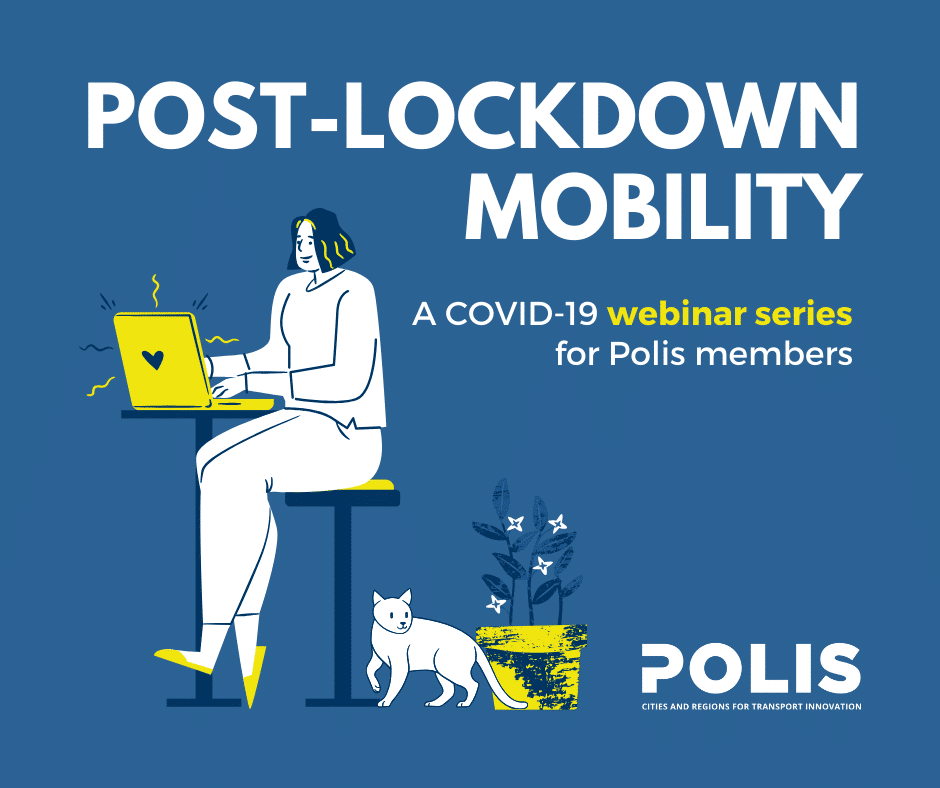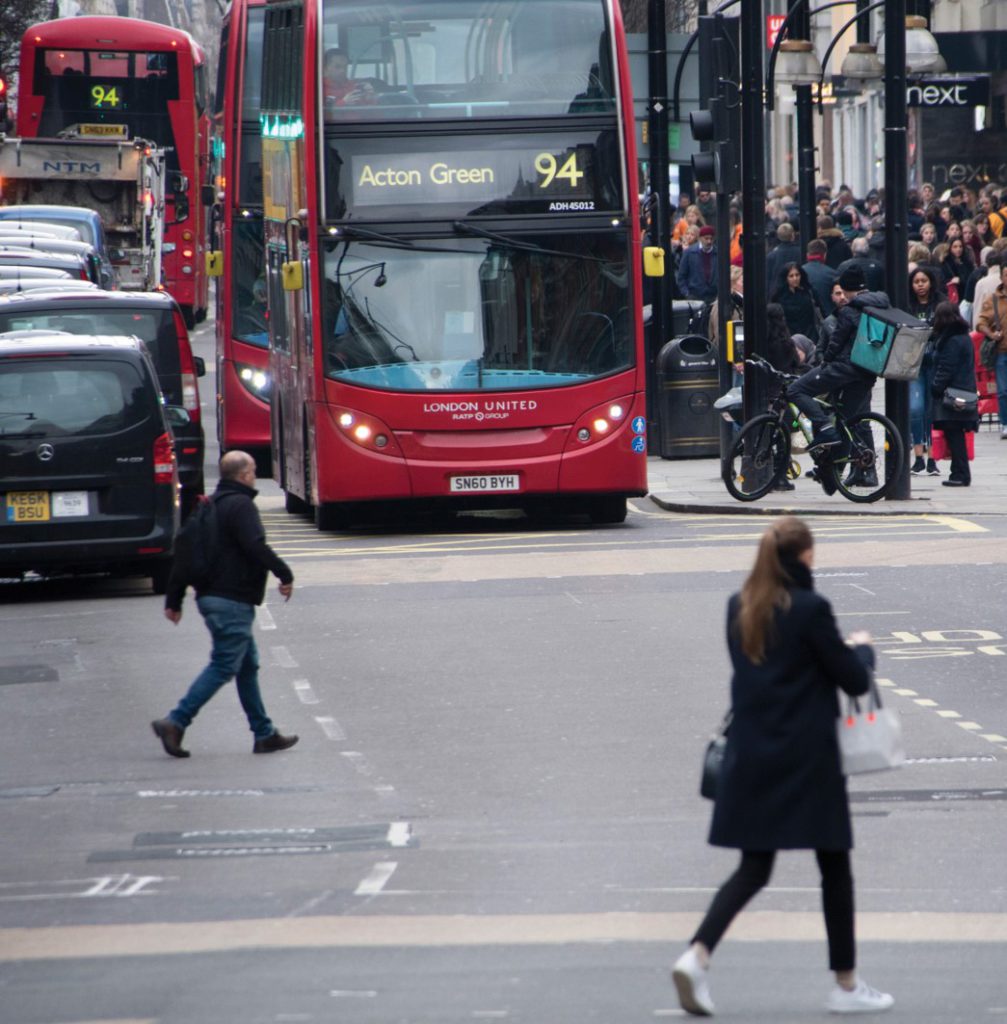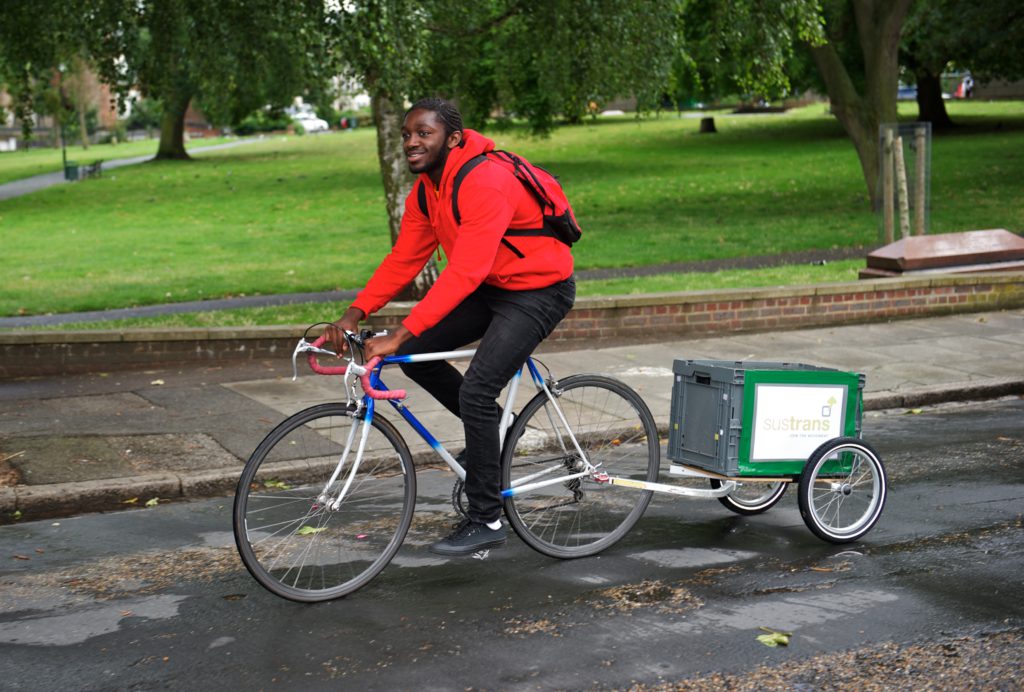Post-Lockdown Mobility report: Reallocation of road space to promote active travel
The session was chaired by Maria José Rojo, Project Manager and Coordinator for the Active Travel and Health Working Group at POLIS. Maria José highlighted that this is the first webinar in the Post-Lockdown Mobility series with a more specific thematic focus, aligned with the POLIS Working Groups. The themes of further Working Groups will be covered in following webinars. She also mentioned that given the high interest in space reallocation among cities, a second webinar on this topic will take place on 28 May.
Andy Cope, Director of Insight at Sustrans
Andy Cope opened his presentation by introducing Sustrans, the UK charity working with cities to make it easier for people to walk and cycle. Andy provided context of how urban mobility has changed in light of COVID-19, noting that UK cities initially took some time to respond to lockdown conditions in mobility. Sustrans responded by offering information and guidance to cities. The first schemes to reallocate road space for walking and cycling in the UK began to appear in mid-April, but since early May, action has increased considerably.
Sustrans has been carrying out three main actions to support the reallocation of road space for walking and cycling:
1) Support for cities
It was noted that some local authorities were uncertain in how road space could be reallocated. In response, Sustrans (alongside other actors like the UK Department for Transport) is providing guidance to cities to show what is possible in creating safe space for active travel, and how cities can implement these projects. Andy highlighted POLIS’s work on COVID-19 and mobility as having been a useful resource to highlight international best practices on road space reallocation.
2) Tactical urbanism
Sustrans is developing a practical guide to help cities implement changes, with three key steps: a) Prioritising space for essential travel and exercise, 2) Getting an agreement in place between key actors, and c) Using trial periods for long-term mobility plans.
3) Space to Move
Sustrans recently launched Space to Move, a new interactive map tracking road space reallocation projects across the UK. The tool highlights a range of measures, including street closures, pavement widenings, and safe cycle lanes. Space to Move shows how road space reallocation projects have increased significantly in recent days, with a doubling of projects across the UK between 8 May and 14 May.
 Andy highlighted examples of actions being taken at a national and regional level to support safe walking and cycling during COVID-19. The Scottish Government made one of the first financial commitments in the UK for road space reallocation in late April, announcing a £10 million fund to support local authorities, which Sustrans will be actively involved with as a key partner of the Scottish Government on active travel. This was followed by the announcement of the Mayor’s Streetspace Plan in London and a £5 million investment in Greater Manchester. More recently, the UK Government announced a £250 million investment to support local authorities with walking and cycling infrastructure
Andy highlighted examples of actions being taken at a national and regional level to support safe walking and cycling during COVID-19. The Scottish Government made one of the first financial commitments in the UK for road space reallocation in late April, announcing a £10 million fund to support local authorities, which Sustrans will be actively involved with as a key partner of the Scottish Government on active travel. This was followed by the announcement of the Mayor’s Streetspace Plan in London and a £5 million investment in Greater Manchester. More recently, the UK Government announced a £250 million investment to support local authorities with walking and cycling infrastructure
Andy closed by making some general conclusions about the road space reallocation situation in the UK:
- Redirection of existing money: Much of the investment made by national and regional governments to reallocate road space came from pre-existing plans. This will see funds re-purposed to speed up the delivery of safe active travel routes.
- Empowering local authorities: Local authorities had a lot of uncertainty as to what they had the power to do, but now thanks to support from Sustrans and the Department for Transport, local authorities have reassurance and guidance in taking action
- Taking a dynamic approach: You can “just do things”! The speed at which measures have been implemented is asking questions of the normal approach for creating active travel infrastructure
- Temporary vs. permanent: Some uncertainties and differences in opinion exist in making these temporary measures into permanent solutions for active travel
- Routes or networks? Currently many of these schemes are small in extent, but in some cities road space reallocation projects are starting to create active travel networks across the city
- Costs lower? Uncertainties remain, but quick, simple measures could bring cost savings
- International examples: Good practice from the likes of Rome, Milan and Brussels has been an inspiration to cities in the UK. Could the new commitments in the UK serve as an example for other cities and countries?
Morgan Dye, Principal City Planner at Transport for London (TfL)
Morgan set out the emerging activity in road space reallocation in London from a city-wide perspective. Morgan noted how urban spaces have changed almost overnight across the world, and that London is no exception to this, with travel down significantly. In March, public transport use was down as much as 95%, posing serious challenges for TfL.
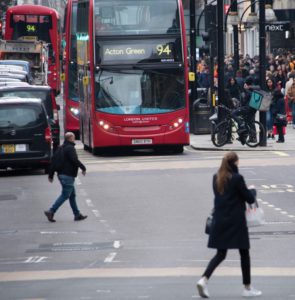 As London prepares to move into a new phase and looks to the future, TfL are asking how to restart the city in a safe, green and sustainable way. With public transport limited to allow for safe social distancing, efforts are being taken to prioritise walking and cycling to avoid a shift to increased car use. Active travel measures, many of which were already in the pipeline, will be fast-tracked to keep people safe and make up for the lack of public transport. TfL are predicting that cycling rates could increase as much as ten-fold under current plans.
As London prepares to move into a new phase and looks to the future, TfL are asking how to restart the city in a safe, green and sustainable way. With public transport limited to allow for safe social distancing, efforts are being taken to prioritise walking and cycling to avoid a shift to increased car use. Active travel measures, many of which were already in the pipeline, will be fast-tracked to keep people safe and make up for the lack of public transport. TfL are predicting that cycling rates could increase as much as ten-fold under current plans.
A key priority in adapting mobility to COVID-19 is the Mayor’s Streetspace Plan, which will see the rapid construction of a strategic cycle network, focus placed on encouraging the use of local services and local journeys by foot or bike, and reducing traffic on residential streets to create low-traffic neighbourhoods. TfL has already started to implement road space reallocation measures on roads under its management, such as closing off streets to traffic using low-cost measures and creating temporary cycle lanes.
Morgan highlighted that much more action on the Streetspace Plan can be expected in the coming weeks and months, with additional measures announced to take pressure off public transport and avoid a shift to car use. Over the long term, TfL will use these plans to build on the ambitions of the Mayor’s Transport Strategy.
Morgan closed by reiterating that there is political will to deliver a safe, sustainable and fair recovery for London, and that recent announcements from the UK Government will help to make road space reallocation for walking and cycling more widespread in the capital.
Simon Phillips, Transport and Public Realm Strategy Manager at the Borough of Lambeth
Simon shared the experience of Lambeth, one of thirty-three local boroughs in London. Simon noted that London and the UK more generally were fairly slow to adapt mobility to COVID-19, and that this had driven leadership and action at the local level in many cases. Lambeth took the decision some weeks ago to roll out active travel measures to protect people when travelling, with other boroughs following suit since then.
Multiple challenges have arisen in Lambeth, both with road space reallocation and in adapting mobility to COVID-19 more generally. Priority has been placed on supporting vulnerable groups, with a new system set up to provide these people with essential supplies through a local cargo-bike service. Ensuring that key workers - such as health workers - can still get to work has been a key concern, ensuring that vital public transport services are still available for those that need them. Additionally, supporting the local economy in Lambeth has been prioritised, with an online platform set up to allow local businesses to offer their services to residents. Simon also noted that challenges exist in the fairness and equality of restrictions on movement, with low-income and minority communities being impacted most in Lambeth. Measures to ensure that people with disabilities can continue to travel safely - whether by foot, bike, public transport or car - are being investigated.
Simon noted that TfL has acted very quickly on this, with reallocation happening overnight in some cases. Looking forward, 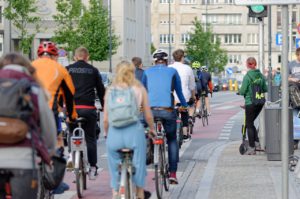 major capacity problems will occur on public transport, with buses and underground services only able to safely cater to 12-15% of normal passenger numbers, meaning millions of journeys a day in London have to be made through other means. To avoid a shift to car use in Lambeth, efforts have been made to implement a number of schemes for active travel, particularly for walking. Temporary pavement widenings have been rolled out in strategic areas such as town centres. There has long been a need for greater space for walking in these areas, but challenges will occur when vehicle numbers once again start to increase. Simon noted that these temporary measures are, perhaps unexpectedly, not always cheap to implement; materials have to be hired, and have to be monitored on a daily basis, generating high costs.
major capacity problems will occur on public transport, with buses and underground services only able to safely cater to 12-15% of normal passenger numbers, meaning millions of journeys a day in London have to be made through other means. To avoid a shift to car use in Lambeth, efforts have been made to implement a number of schemes for active travel, particularly for walking. Temporary pavement widenings have been rolled out in strategic areas such as town centres. There has long been a need for greater space for walking in these areas, but challenges will occur when vehicle numbers once again start to increase. Simon noted that these temporary measures are, perhaps unexpectedly, not always cheap to implement; materials have to be hired, and have to be monitored on a daily basis, generating high costs.
To deal with congested areas around underground stations, action has also been taken to reallocate space from bus lanes around key underground entrances to ensure people have ample space and can conform with physical distancing rules. Lambeth has a strong plan in place to create more safe walking and cycling routes, such as the Healthy Route Network and Low Traffic Neighbourhoods plans, which are being fast-tracked in light of COVID-19 to help residents get around safely and easily on foot and by bike.
Simon closed by noting that whilst we are faced with a serious crisis, this is also a huge opportunity to mainstream walking and cycling in the future and make active travel - cycling in particular - easier and more attractive for a wider range of people. This will be vital in locking in benefits such as improved air quality. Simon noted that whilst TfL and local boroughs are doing very well under the circumstances, resources and finances are severely constrained, and more support from national government will be needed to protect public transport and enable road space reallocation projects to be rolled out more widely in boroughs like Lambeth.
A recording of the webinar and presentations from the session is available exclusively for our members on the members area of the POLIS website. For more information about the webinar series, please see our website.
